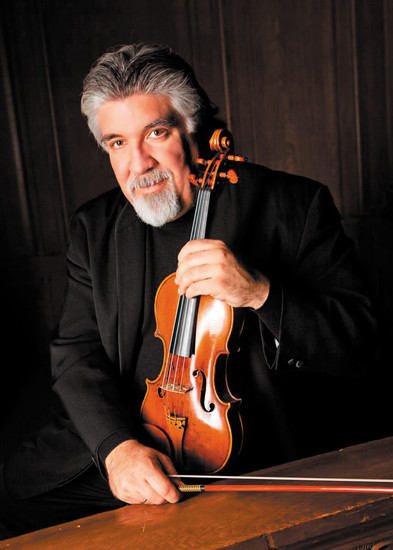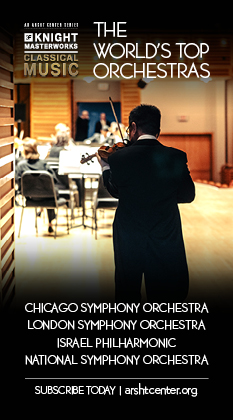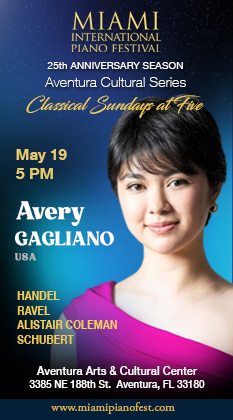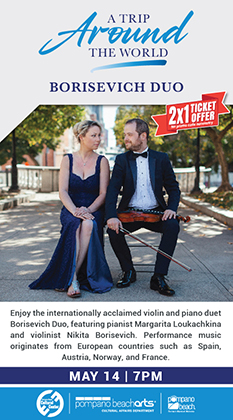The Symphonia opens the new year with a string-friendly program

Strings were the thing at Sunday’s concert by The Symphonia, and as usual, the violin was the star.
The brass, wind and percussion sections took the day off, leaving the stage at Saint Andrew’s School in Boca Raton to the chamber orchestra’s violins, violas, cellos and double basses, plus a harpsichord.
Appearing as conductor and soloist was Andrés Cárdenes, former concertmaster of the Pittsburgh Symphony Orchestra, who represents an illustrious lineage of violinists.
He studied with Joseph Gingold, concertmaster of the Cleveland Orchestra in its glory years under conductor George Szell. Gingold studied with Eugene Ysaÿe, considered by many the greatest violinist of the early 20th century, and Ysaÿe studied with Henri Vieuxtemps, one of the great virtuoso violinists and composers of the 19th century.
Cárdenes served as soloist in two violin concertos by Antonio Vivaldi, from a concerto set called “La Stravaganza,” variously translated as The Extravagance or The Eccentricity. The works represent the upper level of Baroque violin virtuosity. With his smooth bowing and well-articulated playing, Cárdenes turned out to be an outstanding Vivaldi exponent.
In the first movement of the Concerto in E Minor, Cárdenes’s superb tone production made Vivaldi’s rapid and complex figurations resound through the hall, with the cascades of notes never becoming a formless blur.
Clear and forceful with his iron-fingered technique, the rapid scales and arpeggios swelled to climaxes and ebbed away, never turning into the rote patterns they could be in lesser musical hands. In the second movement, he brought a singing tone and seamless phrasing to the long, operatic melody.
Although there were intonation issues in the ensemble throughout the concert, the orchestra gave him firm support, with transparent playing and a strong sense of rhythm.
The opening movement of the Concerto in D Major resembled the previous work in technical demands, which he handled easily and with musical intelligence. In the slow movement Cárdenes played the long melody with restless intensity, clearly articulating the rapid wisps of ornamentation to the melody.
In tone and texture, the final movement resembled the famous first movement of Vivaldi’s “Spring” concerto from The Four Seasons. The technical acrobatic here called for him to bow across multiple strings, which he did with vigor and clarity, with the movement’s joyful tone coming through in his virtuosity.
The program opened with Javier Montiel’s set of variations for orchestra on the famous theme from the Caprice No. 24 of Nicolo Paganini, often considered the greatest violinist ever. This string orchestra version with occasional violin solos was retooled by Cárdenes from Montiel’s arrangement for string quartet.
The result was mixed. The first variation, taken from one of Paganini’s own variations on the theme, which calls for rapid playing with the bow bouncing across the strings, is difficult enough for one violin. For an entire violin section, the results came pretty close to cacophony on Sunday.
The most impressive moment came when concertmaster Mei Mei Luo played a variation that appeared to come intact from Paganini’s version, a difficult passage in which the violinist plays pizzicato with the left hand while bowing with the right; Luo’s left-hand pizzicato rang out loud, fast and clear.
The best playing came in the final work, Gustav Mahler’s arrangement for string orchestra of Schubert’s String Quartet in D Minor, known as “Death and the Maiden.”
Despite the heavier instrumental forces, the Symphonia’s result was surprisingly transparent. The gruff, abrupt opening came off sharp and stark, foreshadowing the twilight music that would follow. Mahler’s addition of double-basses made an impact throughout, giving the ensemble a tone that was deeper and darker than the familiar quartet version.
Some of the drive of the opening, however, seeped into the genial second theme, one of those classic Schubert melodies that here came off as a bit rushed and offhand, without the natural phrasing it seemed to call for.
The opening of the Andante, which takes its theme from the Schubert’s song that gives the work its title, came off with apt restless urgency, without a trace of the plodding tone that could have crept into it. The first variation was fleet and light. Cellos gave a poignant, expressive account of the melody in the second variation, although the crucial, busy accompaniment in the upper strings were a bit faint.
The musicians played the concluding Presto with dark tones and fine ensemble precision. The passage where the quick melody stops short for a series of chords came off with symphonic grandeur.
The Symphonia’s next concert will take place 3 p.m. March 27 at Saint Andrew’s School. Conductor Laura Jackson leads a program including Julia Adolphe’s Shiver and Bloom, Britten’s Variations on a Theme of Frank Bridge, and Beethoven’s Piano Concerto No. 3 with soloist Marika Bournaki. thesymphonia.org
Posted in Performances
Leave a Comment
Mon Jan 10, 2022
at 12:11 pm
No Comments




